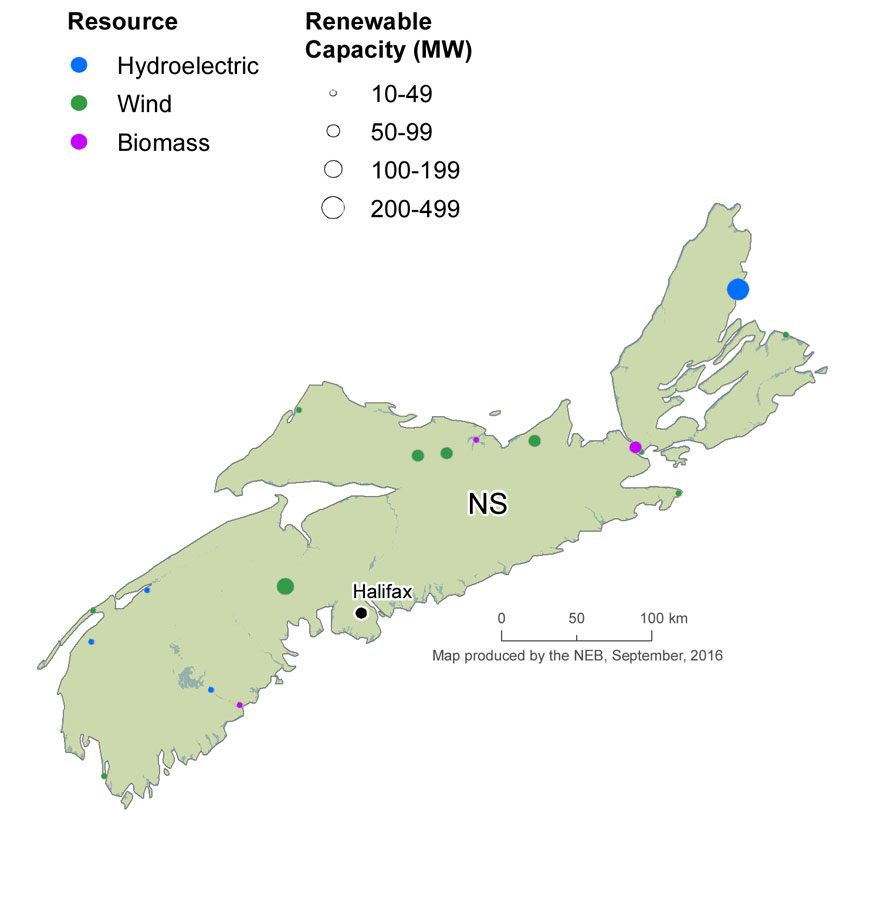ARCHIVED – Canada’s Renewable Power Landscape 2016 – Energy Market Analysis
This page has been archived on the Web
Information identified as archived is provided for reference, research or recordkeeping purposes. It is not subject to the Government of Canada Web Standards and has not been altered or updated since it was archived. Please contact us to request a format other than those available.

Nova Scotia
In 2015, Nova Scotia generated 2 659 GW.h of electricity from renewable sources, mainly wind and hydro. In the past ten years, the share of generation from renewables increased from 12% to 24%.
Nova Scotia generates the highest percentage of electricity from wind in Canada, after PEI.
Nova Scotia Power, an investor owned utility, controls most of the generation assets in the province. Independent power producers own the majority of the wind and biomass facilities.
Nova Scotia has an increasingly diverse electricity supply mix including coal, oil, natural gas, and renewables. In 2005 generation from fossil fuels, mostly coal, accounted for over 80% of the total. In 2015 this declined to about 70%.
In 2010 Nova Scotia adopted a Renewable Electricity Standard designed to increase generation of electricity from renewable resources. This legislated standard requires 25% of the province’s electricity to come from renewable sources by 2015 and increase to 40% by 2020. To support these targets the province introduced programs such as Enhanced Net Metering, Community Feed-in Tariffs, Developmental Tidal Feed-in Tariff, a Commercial Renewables Program, and other initiatives.
Nova Scotia is home to the only tidal power plant in North America, and one of few in the world. The Annapolis Tidal station, built in 1984, has a 20 MW generating capacity.
Nova Scotia is looking to develop its vast tidal energy resource. In 2012 the province introduced the Marine Renewable Energy Strategy which targeted 300 MW of power from in-stream tidal energy projects. To meet this goal, the Marine Renewable Energy Act was introduced in 2015.
In 2015, the province introduced the Developmental Tidal Feed-in Tariff program which is specific to in-stream tidal projects (0.5 MW or higher). A number of independent producers have expressed interest in this program and so far there are five proposed projects with a combined capacity of 22 MW.
| Capacity in MW and % | Generation in GW.h and % | |||
|---|---|---|---|---|
| 2005 | 2015 | 2005 | 2015 | |
| Hydro | 404 | 376 | 1 075 | 1 003 |
| 16% | 13% | 9% | 9% | |
| Wind | 37 | 444 | 85 | 1 015 |
| 1% | 15% | 1% | 9% | |
| Biomass | 69 | 113 | 318 | 641 |
| 3% | 4% | 3% | 6% | |
| All renewable sources | 507 | 933 | 1 479 | 2 659 |
| 21% | 32% | 12% | 24% | |
| All sources | 2 447 | 2 925 | 12 540 | 11 028 |
This table shows Nova Scotia's electric capacity and generation from renewables in 2005 and 2015. The share of hydro in total capacity decreased from 16% to 13% while the share of wind increased from 1% to 15% and the share of biomass from 3% to 4%. The share of hydro in total generation remained stable at 9% while the share of wind increased from 1% to 9% and the share of biomass increased from 3% to 6%.

FIGURE 19 Renewable Resources and Capacity in Nova Scotia

Text version of this map
This map shows the location and approximate capacity of renewable power plants with a capacity of at least 10 MW across Nova Scotia. Resources are spread throughout the province. The largest hydro plant is located in the northeast while the largest windfarm is located in the centre of the province. There are no solar resources with a capacity of at least 10 MW.
FIGURE 20 Electric Generation Capacity in Nova Scotia

Text version of this graphic
This bar graph shows Nova Scotia’s total electric capacity in 2005 and 2015 for all fuel sources. Capacity increased from 2 447 MW to 2 925 MW, with renewables increasing from 21% to 32% of total capacity.

- Date modified:
